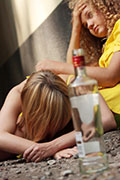- Understanding the Connection Between Anxiety and Depression
- How Daily Prunes Can Influence Cholesterol and Inflammation
- When to Take B12 for Better Absorption and Energy
- Epsom Salts: Health Benefits and Uses
- See What Saffron Can Do for Sleep and Heart Health
- 6 Common Mistakes to Avoid Before Your Physical
- Can Sweating Really Help You Beat a Cold?
- Strengthening Your Relationship: Practical Strategies
- Skip Storing This Everyday Product in the Fridge Door
- Green Tea + B3 Pairing May Boost Brain Health
Some Sobering Stats on Kids and Drinking


Alcohol poses a far greater threat to children than many parents care to admit, a new report warns.
Many kids start drinking at a young age, and their size and inexperience with alcohol renders them more apt to be binge drinkers, said report author Dr. Lorena Siqueira, director of adolescent medicine at Nicklaus Children’s Hospital in Miami.
Such hard drinking can prove fatal. For example, one-third of all fatal auto crashes involving alcohol happen among 15- to 20-year-olds, the report found.
“The top three causes of mortality in teenagers are motor vehicle accidents, homicides and suicides, and alcohol is strongly associated with each of these,” Siqueira said.
Between 36 percent and 50 percent of high school students drink alcohol, and 28 percent to 60 percent report binge drinking, the report said.
But the true picture is even darker, Siqueira suggested. Those numbers are based on the adult definition of binge drinking — five or more drinks in a two-hour period for men, or four or more drinks for women.
Because teens typically weigh less than adults, they are likely to reach an unsafe blood alcohol concentration faster, Siqueira said.
Alcohol isn’t benign, one expert agreed.
“We spend a lot of time worrying about all manner of substance abuse, and we should, but this report brings home that the most commonly abused and dangerous drug for children is alcohol,” said Dr. Bennett Leventhal, a professor of child and adolescent psychiatry at the University of California, San Francisco.
In 2014, half of twelfth graders and one in nine eighth graders reported having been drunk at least once in their life, the report found.
The way kids drink alcohol makes them more apt to drink too much, Siqueira noted.
“When they drink, they often tend to drink straight from a bottle and they pass it around,” she said.
The report lists an array of health problems that stem from underage drinking:
- Half of all head injuries in teens are associated with drinking.
- Binge drinking has been associated with earlier sexual activity, teenage pregnancy and sexually transmitted diseases.
- Kids who start drinking before age 15 are four times more likely to become alcoholic, compared with people who start drinking after 20.
- Early drinking also can alter brain development, affecting attention, among other things.
Children start to think positively about alcohol as early as between the ages of 9 and 13, the report found.
These kids are influenced by what they see in the world around them, Leventhal said. They see enticing ads for alcoholic beverages, watch role models use alcohol, and even see the adults around them drinking.
Parents need to be prepared to talk frankly with their kids about alcohol at a very early age, like elementary school, said Marcia Lee Taylor, president and CEO of the Partnership for Drug-Free Kids.
“As parents we all need to own it, that if we aren’t the ones talking to our children and informing their views, then someone else is going to do it,” Taylor said.
In these conversations, parents should talk about how to drink responsibly, and how adult drinking is different from the drinking in which their young friends are engaged, Siqueira said.
For example, adults tend to eat while they drink to reduce the effects of alcohol, she said. They don’t drink very fast or straight from the bottle.
Taylor said parents also need to model good drinking behavior. They shouldn’t describe alcohol as something they need to relieve stress, and they should avoid drinking to excess in front of their children.
The report urges pediatricians to ask kids about their exposure to alcohol. “If your physician wishes to talk to your kid alone, that’s recommended as a good approach to dealing with a teenager,” she said.
Above all, parents should not assume that drinking is just something that happens as a child grows older, and that they have no way to slow or stop it, Taylor said.
The new report noted that 80 percent of teenagers say their parents are the biggest influence on their decision whether to drink, Taylor said.
More information
For more on underage drinking, visit the U.S. Centers for Disease Control and Prevention.
Source: HealthDay
Copyright © 2026 HealthDay. All rights reserved.










